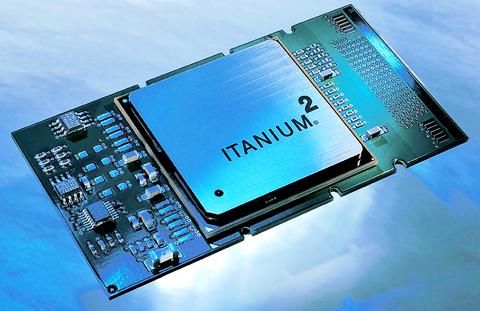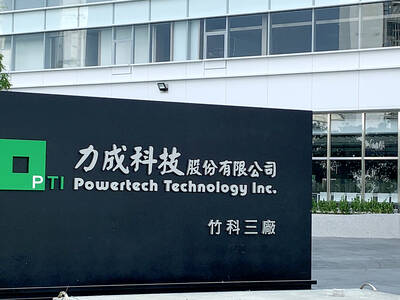Google -- the Internet's leading search engine, powered by an arsenal of computers with 15,000 microprocessors -- should be a premier customer for Intel's new Itanium 2 super-chip.
Itanium, a joint project of Intel and Hewlett-Packard, Silicon Valley's two largest companies, has been in the laboratory for more than a decade. Itanium is designed to excel at a sweeping array of advanced computing tasks, from solving grand scientific challenges to rendering complex graphics to slicing through vast databases. With more than 200 million transistors on each chip, it is designed to process data in big bites -- 64 bits, in chipspeak -- at blazing speeds.

PHOTO: NY TIMES
But Google isn't buying. And that is an ominous sign for what is one of the longest-running and most expensive computing projects in history -- exceeded only by IBM's bet-the-company gamble on its 360 mainframes, which eventually succeeded.
For Intel, Itanium's failure would be a painful black eye, a setback in its heavily financed assault on the corporate computing world beyond the personal computer. For its partner, Hewlett-Packard, the chip venture, if anything, is even more important. Exploiting the Itanium opportunity was crucial to the thinking behind HP's US$19 billion merger this year with Compaq Computer. If Itanium fails, it will be a severe blow.
And if Itanium flops, Silicon Valley's psyche may well be shaken, too. Projects like Itanium are the valley's equivalent of going to the moon. Big budgets, big egos and a near-religious commitment to the "right way" to design a computer are involved. With Silicon Valley mired in its worst recession, some technologists there say that Itanium may be the industry's last such huge bet on computer design.
Intel still says its commitment to Itanium is unwavering. Its smaller rival, Advanced Micro Devices, has an alternative to Itanium that computer makers are seriously considering. And Intel has a fallback project, called Yamhill, in case Itanium founders. But mainly, Intel is redoubling its bet on Itanium.
It has taken an entire decade, an estimated US$5 billion and teams of hundreds of engineers from the two companies to bring the first Itanium chip to market. As the struggles and costs mount for the companies, skeptical technologists say Itanium now has the hallmarks of a bloated project in deep trouble. It is already four years behind schedule, emerging just as companies are in no mood to spend money on technology.
"Every big computing disaster has come from taking too many ideas and putting them in one place, and the Itanium is exactly that," said Gordon Bell, a veteran computer designer and a Microsoft researcher.
Increasingly, Intel is facing the risk that it has chosen the wrong path to high-performance computing. It may have looked backward as it developed the microchip equivalent of the behemoth computers of the past.
A new direction
Dr. Eric Schmidt, the computer scientist who is chief executive of Google, told a gathering of chip designers at Stanford last month that the computer world might now be headed in a new direction. In his vision of the future, small and inexpensive processors will act as Lego-style building blocks for a new class of vast data centers, which will increasingly displace the old-style mainframe and server computing of the 1980s and 1990s.
It turns out, Schmidt told the audience, that what matters most to the computer designers at Google is not speed but power -- low power, because data centers can consume as much electricity as a city.
If power efficiency does indeed trump processing speed, everything that Intel and HP have done to pack raw power into the 221 million transistors of the new Itanium 2 could now be a handicap. The chip, which is as large as a silver dollar and whose 130 watts of power dissipation are enough to fry the proverbial egg, is not even a contender in the Google universe. "We're incredibly, incredibly power sensitive, and we've been talking to Intel about that," Schmidt said.
So far, Intel and HP have been hard-pressed to prove they are on the right track. The Itanium was announced in 1994 as a joint effort to design a processor for the world of large computing systems, like servers, mainframes and supercomputers.
The project, however, has been beset by repeated delays. Originally planned to arrive in late 1997, the chip did not arrive commercially until last year.
Worse, the first version of Itanium, code-named Merced, proved to be an embarrassing dud -- its performance trailing even Intel's own 32b Pentium chips, let alone the rival chips it is intended to beat, like IBM's Power series or Sun Microsystems' Ultrasparc 64b processors.
New technologies and economics
Itanium is Intel's effort to apply the economics of the personal computer business, with its lower costs of mass production and swift technological improvement, to the lucrative market for computer data centers of corporations and government. IBM and Sun Microsystems, with their big server computers and 64b chips, are the leaders in the data center market -- and the target of Intel and its partners from the personal computer industry, like HP, Dell Computer and Microsoft.
The more powerful Itanium 2 was introduced in July, but market researchers now project that Itanium will garner less than 10 percent of the market for server computing as far ahead as 2007. Intel executives have not disputed those forecasts.
Yet Michael J. Fister, the veteran Intel manager who was called in to rescue the Itanium project three years ago, says the project has finally turned around. A little patience may be needed, he says, but what lies ahead for Itanium is opportunity, not insurmountable problems.
HP may have even more riding on Itanium than does Intel. The chip is a big part of the company's goal to gain an edge over IBM, Sun Microsystems and Dell in corporate computing.
As a co-developer of the Itanium technology, Hewlett-Packard will get deep discounts on the price of each chip. That will give HP a significant cost advantage over rivals.
In an interview last December, before shareholders approved Hewlett's purchase of Compaq, Richard A. Hackborn, a board member and a former senior executive, portrayed Itanium as a potentially crucial advantage for the combined company.
As part of its partnership with Intel, Hewlett was granted early access to chip designs and a deeper understanding of the technology, Hackborn said. So it will have a technical edge on other makers of Itanium-based servers, he argued, in addition to lower costs. That could make Hewlett the lead integrator of the Intel microprocessor and Microsoft operating systems in corporate data centers.
In with the big boys
"That's a huge opportunity," Hackborn said. If Hewlett can exploit that opportunity, he added, "That puts the new HP on a comparable footing with Intel and Microsoft."
There are other benefits for Hewlett-Packard. The Itanium allows the company to eliminate both of its current 64b chips -- the HP PA-RISC and Compaq Alpha. That alone should save the company US$200 million to US$400 million annually in development and manufacturing costs, according to Steven M. Milunovich, an analyst at Merrill Lynch.
Yet if Itanium fails, he said, "the real loss is the opportunity cost."
In the commercial market, HP badly needs a credible strategy and a marketing message. Itanium, Milunovich said, is an essential part of the plan establishing Hewlett as the leading packager and integrator of Itanium-based systems.
"If everything works according to plan, HP could be best positioned to be the company to take PC economics into the enterprise," Milunovich said.
If Itanium fails, he added, HP will be forced to go with Yamhill or AMD, and it will lose its hoped-for advantages in making large data-serving computers.
In the end, Itanium may be most vulnerable to a force that neither Intel nor HP can control: the economy. Even if Itanium proves a technical success, the most powerful incentive for companies to shift to it lies in the high-performance computing power needed for ambitious new information technology projects. But in the sluggish economy, few companies are increasing capital spending.
"The real challenge to the Itanium may have less to do with marketing and design and more to do with a collapsing economy," said Michael Shulman, an analyst at ChangeWave, a research firm in Potomac, Maryland.
Shulman's firm regularly asks corporate information technology managers about spending plans. From last summer to this summer, he said, interest in the Itanium eroded sharply as spending on new computing projects was reined in.
"The common view is, `If it doesn't save us money we have no interest in it,'" Shulman said. "It's a very hard-nosed view."

US sports leagues rushed to get in on the multi-billion US dollar bonanza of legalized betting, but the arrest of an National Basketball Association (NBA) coach and player in two sprawling US federal investigations show the potential cost of partnering with the gambling industry. Portland Trail Blazers coach Chauncey Billups, a former Detroit Pistons star and an NBA Hall of Famer, was arrested for his alleged role in rigged illegal poker games that prosecutors say were tied to Mafia crime families. Miami Heat guard Terry Rozier was charged with manipulating his play for the benefit of bettors and former NBA player and

The DBS Foundation yesterday announced the launch of two flagship programs, “Silver Motion” and “Happier Caregiver, Healthier Seniors,” in partnership with CCILU Ltd, Hondao Senior Citizens’ Welfare Foundation and the Garden of Hope Foundation to help Taiwan face the challenges of a rapidly aging population. The foundation said it would invest S$4.91 million (US$3.8 million) over three years to foster inclusion and resilience in an aging society. “Aging may bring challenges, but it also brings opportunities. With many Asian markets rapidly becoming super-aged, the DBS Foundation is working with a regional ecosystem of like-minded partners across the private, public and people sectors

BREAKTHROUGH TECH: Powertech expects its fan-out PLP system to become mainstream, saying it can offer three-times greater production throughput Chip packaging service provider Powertech Technology Inc (力成科技) plans to more than double its capital expenditures next year to more than NT$40 billion (US$1.31 billion) as demand for its new panel-level packaging (PLP) technology, primarily used in chips for artificial intelligence (AI) applications, has greatly exceeded what it can supply. A significant portion of the budget, about US$1 billion, would be earmarked for fan-out PLP technology, Powertech told investors yesterday. Its heavy investment in fan-out PLP technology over the past 10 years is expected to bear fruit in 2027 after the technology enters volume production, it said, adding that the tech would

YEAR-END BOOST: The holiday shopping season in the US and Europe, combined with rising demand for AI applications, is expected to drive exports to a new high, the NDC said Taiwan’s business climate monitor improved last month, transitioning from steady growth for the first time in five months, as robust global demand for artificial intelligence (AI) products and new iPhone shipments boosted exports and corporate sales, the National Development Council (NDC) said yesterday. The council uses a five-color system to measure the nation’s economic state, with “green” indicating steady growth, “red” suggesting a boom and “blue” reflecting a recession. “Yellow-red” and “yellow-blue” suggest a transition to a stronger or weaker condition. The total score of the monitor’s composite index rose to 35 points from a revised 31 in August, ending a four-month